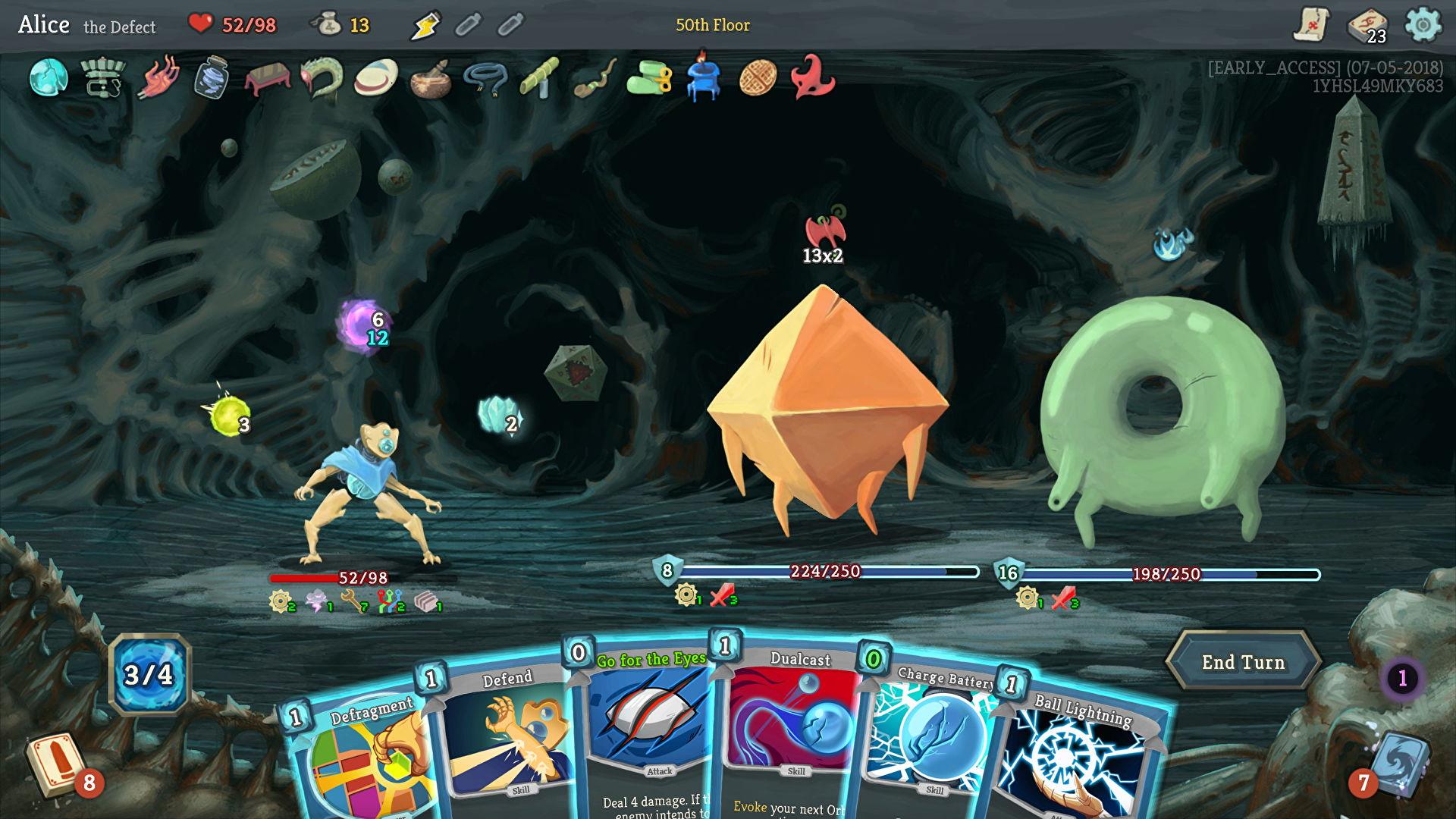Slay the spire is a roguelike deck-building game developed by Mega Crit Games, and is available on all platforms. It’s target audience is probably originally fans of collectible card games (like Magic) and deck-building games (like Dominion), but it quickly drew mainstream attention and pioneered the digital roguelike deck-building game.

Important Formal Elements
Objective: Slay the spire is comprised of a series of battles, with chances to upgrade your deck and hero sprinkled in between. The objective of each battle is simply to beat your enemies, which would suggest the objective is capture. However, since the enemies telegraph their next action every turn, combat really plays out more like a puzzle game where the objective is solution. The player needs to decide when to defend, when to attack, and how to beat the enemy while taking the smallest amount of damage.
Resources: The player’s primary resource is their deck of cards. Each hero always starts with the same basic pool of cards, but beyond that, the player has complete control over which additional cards to add, upgrade, or remove. Of course, since the game is a roguelike, the player is offered difference choices every time. In my opinion, this deck building element, rather than the battles themselves, is what makes Slay the spire so fun and popular. The player can play the game “properly”, always choosing the best option at any given moment during a run and constantly adapting, or the player can “force” specific builds they have in mind and just hope that they end up getting the cards they need for that build through the run. Slay the spire, ingeniously, supports and rewards both playstyles.

Types of fun intended
The strongest fun offered by slay the spire is probably the fun of expression- coming up with your own strategies and executing on them is the best part of the game. In fact, calling it the fun of execution is probably more appropriate in this context. The fun of expression is served with a delicious side of discovery, as the player unlocks more and more cards they can incorporate into their strategies. Thirdly, the fun of challenge is delivered as well – after all, roguelikes rely on their challenge to keep the player coming back. A roguelike where the player reliably wins every time isn’t really a rogue-like – it’s just a short game. Finally, I’d argue that their is an element of fun of submission as well – once a player has largely mastered the game, picking apart the enemies that used to be significant challenges without much effort is like a comforting routine.
Moments of particular success
The best moments I had in Slay the spire were moments where I was rewarded for making the right decision. As I alluded to previously, the combat of slay the spire is all about timing – knowing when to be aggressive and when to be defensive. Be too aggressive, and you might leave yourself open for massive incoming damage. Be too passive, and the enemies will slowly whittle down your health. Killing the enemy with just the right amount of damage before they make a big attack, because I quite literally played my cards right, were the best moments of the game.

The individual cards of Slay the spire are not balanced at all in terms of cost curve or power level. But in the context of a roguelike deck-builder, they are perfectly balanced for fun.
Balance
There is an excellent GDC talk where the creators talk about how they approached balancing. (Fun fact: I was at the talk and asked the questions at the 26:53 mark ^.^) In short, their primary goal with balancing was “every card should have a place”, with the secondary goal of “avoiding anything too warping”. I really like this approach because the creators did not balance the game for the sake of balance – they instead thought of how can balance help deliver the play experience they intended. They accomplished this through tracking the pick rate and win rate of every card in the game, having a Discord where players can provide feedback, and watching streamers play the game.
Under the framework we were given, the creators focused on the third type of balance – making various winning strategies achievable and desirable. Thus, cards are never evaluated on their own and always in the context of how they can be used, and very importantly, how often they can be found. A blatantly overpowered legendary card that the player rarely sees, and only fits within a few strategies is totally fine and even desired – the players that do make good use of it will feel really rewarded. A boring common card that is slightly under-costed would receive nerfs, because the ubiquity and efficiency of the card might mean that players just always put the card in their deck despite it not being very exciting. To accomplish these balancing goals, the designers mainly rely on the “fruity” method, by making cards unique enough such that they naturally fall in to different overlapping strategies, only using transitive balancing when needed.
All of this means that the individual cards of Slay the spire are not balanced at all in terms of cost curve or power level. But in the context of a roguelike deck-builder, they are perfectly balanced for fun.
Thing I would change to make the game better
Make a sequel! But seriously, my biggest gripe with the game is probably the lack of resources to help players improve. As a seasoned TCG and deckbuilder player, I still had to read many Reddit posts to discover many of the synergies, strategies, and best practices for the game. I know several people who were unfamiliar with deckbuilders, gave Slay the spire a shot, and gave up because it was too difficult. Unfortunately, this is a really hard problem to solve, but maybe start with tooltips?



